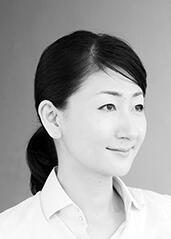 Sawako Kaijima, Assistant Professor of Architecture and Shutzer Assistant Professor at the Radcliffe Institute, challenges students’ preconceptions about material often defined by their disciplinary norms through the use of visual programming to foster an “intuitive understanding of structural engineering in architectural design.” Structural design and architectural design often live separately in teaching and practice but are fundamentally linked. So her Interface Design: Integrating Material Perceptions course seeks to fuse these two disciplines. The use of a software tool developed specifically for this course, which is accessible even to students with no programming experience, “defamiliarizes architecture students from the common way of looking at materials” and introduces them to an engineering perspective right from the start.
Sawako Kaijima, Assistant Professor of Architecture and Shutzer Assistant Professor at the Radcliffe Institute, challenges students’ preconceptions about material often defined by their disciplinary norms through the use of visual programming to foster an “intuitive understanding of structural engineering in architectural design.” Structural design and architectural design often live separately in teaching and practice but are fundamentally linked. So her Interface Design: Integrating Material Perceptions course seeks to fuse these two disciplines. The use of a software tool developed specifically for this course, which is accessible even to students with no programming experience, “defamiliarizes architecture students from the common way of looking at materials” and introduces them to an engineering perspective right from the start.
Using the classroom to challenge the boundaries of a discipline
The benefits
Working with the tool repeatedly “until they get a feel for it” allows students to learn how to connect structural geometry with the geometry of design and, ultimately, to develop their own application. Kaijima reflects that, as a result, students often come up with more progressive designs that are “beyond the current simulation capability,” which pushes them even further to use their creativity to develop something truly innovative.
"I see discipline as an infrastructure: it really regulates how we behave, but also we don't think about it. And any infrastructure requires updates."
The challenges
One of the challenges is that design structures, in particular, have often been taught in a way that makes students feel distant from the topic and from its application to their work. But understanding this separate discipline is fundamental to the inherently interdisciplinary work many students go on to perform through design. “Students are not exposed to this tension, so they don’t have an understanding of the problem.”
Takeaways and best practices
-
Think about what it would take to fuse disciplines.
Kaijima and her colleague developed a tool that fuses “structural simulation software” with “architecture software” to help immerse students into the applied world of architecture that pulls from structure and design simultaneously. This helped students gain the opportunity to “reimagine what it’s like to make something physical” and learn to combine the two disciplines on their own. -
Encourage collaboration.
Setting aside time just for students to talk to one another is critical, since speaking more in these courses can help them develop their own thoughts. “This is a small class and we collaborate a lot,” Kaijima describes. In future online environments, she offers that this might be achieved through asynchronous lectures and reserving class time for discussion. -
Get excited!
Students are catalyzed by the energy a faculty member brings to the classroom. Often, teaching structures doesn’t have the same excitement because, Kaijima notes, “structural calculation are introduced using classical beam theory” which is difficult to connect to mostly graphical architecture design processes. In addition it’s treated as a “separate profession” even if it informs one’s work as a designer. “But I love it, so I’m excited!” Kaijima expresses, and that enthusiasm energizes students to combine these disciplines consciously.
Bottom line
When tackling an interdisciplinary issue, be sincere about the utility you feel it brings to understanding the problem and about the acceptance of “the other disciplines’ values and norms.” Kaijima warns that this can be challenging, considering how unique each discipline is, but it’s also vital. “The value you have for the discipline is reflected to the students as well.”
